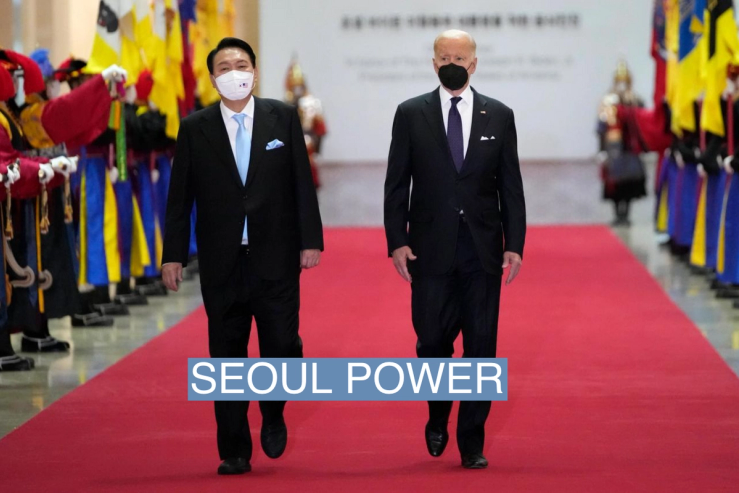The Scoop
U.S. and South Korean officials have begun working more closely together on plans to deter North Korea’s increasing military capability as international diplomacy aimed at combating Pyongyang stalls.
U.S. and Korean officials told Semafor that joint talks on how to respond to the North’s recent advancements on arms, including tactical nuclear weapons, accelerated after U.S. President Joe Biden’s first meeting with South Korean President Yoon Suk Yeol in November.
The two sides have discussed increasing the presence of U.S. naval and air assets in Northeast Asia and working more closely on military planning, in part by expanding joint “table top” exercises used to wargame possible confrontations with the North, including nuclear exchanges. The U.S. also will continue to build up Seoul’s conventional military forces.
President Biden will host Yoon at a White House summit on April 26, and U.S. and Korean officials say discussions there will focus on enhancing South Korea’s policy of “extended deterrence.” Seoul is seeking greater intelligence sharing with the U.S., more say in Washington’s nuclear doctrine in Asia, and better coordination with other U.S. allies.
Know More
Washington and Seoul have been warning for months that the North is preparing to test its seventh nuclear device. While it hasn’t happened yet for reasons that are still unclear, Pyongyang continues to demonstrate its growing nuclear capacities, unnerving its neighbors in Northeast Asia.
On Thursday, North Korea fired an intercontinental ballistic missiles into the waters between South Korea and Japan ahead of a summit between the two counties. It previously paraded its new ICBMS, which the U.S. says are designed to hit the American mainland, through the streets of Pyongyang.
The country also displayed tactical nuclear weapons infrastructure, such as mobile launchers, that North Korean leader Kim Jung Un announced last September are part of a military doctrine that seeks to strike U.S.-allied targets in South Korea and Japan.
Recent attempts to pressure North Korea through the U.N. Security Council have failed, lacking support from China and Russia — a shift from 2017, when Beijing and Moscow joined the U.S. in sanctioning Pyongyang for its last nuclear weapons test. The U.S.’s ambassador to the U.N., Linda Thomas-Greenfield, has accused China and Russia of offering North Korea “blanket protection” and called the lack of Security Council action, “worse than shameful.”
Long-time North Korea watchers, both in Washington and Seoul, say the days of diplomatic cooperation on North Korea between Western powers and China and Russia are likely over, given Russia’s invasion of Ukraine and deteriorating relations between the U.S. and China.
“There’s been a massive geopolitical shift. I don’t think the Chinese or Russians have any incentives to help us with North Korea,” said Joel Wit, a former U.S. State Department official who oversees the 38 North program that closely tracks North Korea. “It’s a very dangerous situation.”
The View From Seoul
President Yoon’s recent suggestion that the U.S. might need to deploy tactical nuclear weapons in South Korea, or South Korea might have to develop them themselves, is a sign of the growing sense of alarm in Asia. “We can have our own nuclear weapons pretty quickly, given our scientific and technological capabilities,” he said in January.
While South Korean leaders have since backtracked and said they remain fully committed to the denuclearization of the peninsula, the government is also facing domestic pressure. A Gallup Korea poll conducted in January found that 77% of the country supports developing nuclear arms.
The View From Beijing
Chinese diplomats told Semafor this week that Beijing remains completely committed to denuclearizing North Korea but argued the U.S. needs to lessen tensions in Northeast Asia. They criticized recent war games between the U.S. and South Korea near the North’s borders and said Western sanctions have become counter-productive.
“The crux of how the Korean Peninsula situation gets to where it is today is clear,” said embassy spokesman, Liu Pengyu. “The main reason is that the parties concerned have refused to respond to the denuclearization measures taken by [North Korea] and continued to pressure and deter.” China supported former President Trump’s direct engagement with Kim.
Jay’s view
I’ve covered the North Korean nuclear program since the 2000s when I was stationed in Seoul for The Wall Street Journal. It’s stunning how dramatically the geopolitical map and security situation in Northeast Asia has changed since then.
Throughout the George W. Bush administration, American diplomats worked closely with Russia and China, as well as the U.S.’s Asian allies, to try and box in North Korea’s nuclear development. Many of the talks were actually hosted by China’s Foreign Ministry in Beijing. The Obama administration created a similar structure during its two terms to try and place Iran’s nuclear program under wraps, making Moscow and Beijing equal partners.
Critics will point out that none of this elaborate diplomacy actually brought lasting agreements to end Pyongyang’s and Tehran’s nuclear ambitions. But it’s almost impossible today to imagine the U.S. convening any international forums involving China and Russia, whose leaders have vastly more leverage over North Korea than the U.S. Those days seem to be over as the world enters a more dangerous neo-Cold War phase.
Room for Disagreement
Some North Korea watchers with whom I’ve spoken are convinced China is quietly counseling Pyongyang to slow down on nukes. China is wary of South Korea and Japan rearming, they believe, and doesn’t want the North to give them more reasons to do so. Kim Jong Un hasn’t tested a nuclear bomb in six years, they note, despite U.S. claims of seeing preparations at the Punggye-ri test site.
Others believe nuclear diplomacy may not quite have dead-ended yet, either. The Singapore Declaration, signed by Kim and Trump in 2018, laid out steps for the U.S. and North Korea to establish diplomatic relations and for the North to disarm. “This could serve at least as a basis for talks,” said a U.S. official.
Notable
- The U.S. and South Korea are attempting to reorient their alliance nearly 75 years after the Korean War. Establishing “extended deterrence” in a changing Northeast Asia will be a challenge, Bruce Klingner writes at the Heritage Foundation.
- The story of a secret mission to overthrow the Kim regime, involving an Ivy League activist, highlights the often bizarre nature of the U.S.-North Korean conflict. My former WSJ colleague, Bradley Hope, pens a cracking narrative.


